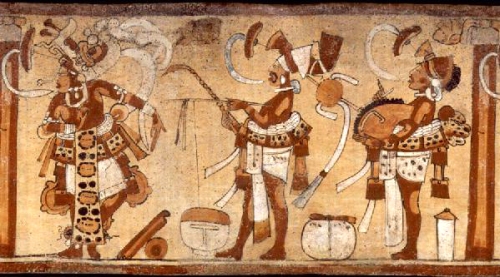Provided mostly by vase paintings and murals, pictorial evidence of the musical practices of the Mayan Classic (ca. 250–900 C.E.) and especially of the Late Classic (ca. 600–800 C.E.) is abundant.
These depictions allow the identification of instrument types—many of them not found as artifacts in archaeological contexts—and their association with specific musical occasions.
What is not always as clear as it may appear is the past musical combination practice of the instruments (and vocal forms) represented in a given picture. Many representations of groups of musicians and musical instruments arouse doubts about their band-like organization or, put positively, give rise to questions about the possible devices used by their painters to indicate musical and social differentiations of such groups.
This according to “Trumpets in Classic Maya vase painting: The iconographic identification of instrumental ensembles” by Matthias Stöckli (Music in art: International journal for music iconography XXXVI/1–2 [spring–fall 2011] pp. 219–230).
Above, a Late Classic Mayan vase painting depicting a friction drum (center); below, John Burkhalter discusses and demonstrates this instrument (demonstration begins at 2:05).




Reblogged this on Cultural Organology and commented:
Cool post about an article on trumpet iconography in Mayan paintings, courtesy of Bibliolore. Check out the video!